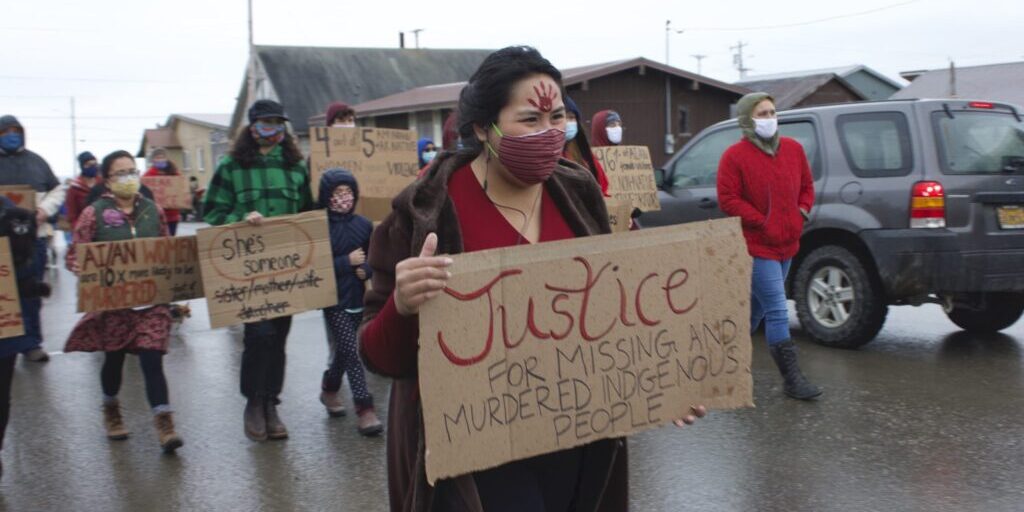A group of red-clad civilians took to the streets of Nome on Saturday to demand justice for missing and murdered Indigenous women KNOM reports that the march honored Florence Okpealuk, a Nome woman who disappeared in August, and other Indigenous people who have gone missing or been killed.
In the middle of a Saturday afternoon, a group of around 35 individuals stood out in the rain. The crowd is mostly made up of women and about four men. Many of them wore red, the color meant to raise awareness for missing and murdered Indigenous women.
“I want to take this time to recognize Florence Okpealuk who has been actively missing…. Today’s day 34.”
-Billi Jean Miller

Billi Jean Miller spoke to the crowd outside of the Nome Public Safety building, home of the Nome Police Department. As of the publishing of this story, Okpealuk has been missing for 38 days.
Miller is hopeful that the epidemic of missing and murdered women will be addressed. She mentioned Operation Lady Justice, a task force formed last year by the U.S. Department of Justice to focus on missing and murdered American Indians and Alaska Natives.
“I believe that if we keep speaking. They will listen.”
– Billi Jean Miller
Okpealuk is the first missing person’s case Nome has seen since the task force began. While the crowd remembered Florence Okpealuk, they also brought forward the names of others who have gone missing or been killed without resolution.
Miller’s own twin sister, Mingnuna Miller was strangled at a hotel in Palmer in 2019. Their mother Diane Miller marched with the group in Nome on Saturday.
“It hurts to this day to have my baby come home in a casket.”
-Diane Miller
Diane has also lost a sister and brother to homicide.
“We are losing too many beautiful Native people, Native women. It hurts. It’s tragic; it hurts families and children, their children; not to come home. I know that feeling.”
-Diane Miller


Alaska Native people make up about 16% of the state’s population but account for 29% of the homicide victims. That’s according to an analysis by the Alaska Justice Information Center.
And most studies and policy makers agree that the numbers around missing and murdered Indigenous people are inconclusive due to a range of factors: including systemic racism in police work, a lack of communication between tribal and federal agencies, along with racial misclassification.
Anna “Aquuluk” Ashenfelter says the problem of missing and murdered Indigenous women is as old as colonization itself.
“The colonizers kind of knew what they were doing when they came here when they kidnapped women and forced the Native men to do their bidding. You kind of still see it played out today just as the numbers are higher. All the numbers are higher for missing and murdered…and you can’t even get an exact number for all the women that are gone.”
– Anna Ashenfelter
Ashenfelter is one of the march organizers. Since October is Domestic Violence Awareness Month, and with Florence Okpealuk still missing, she says it made sense for her to organize the march.
Alaska ranks third for intimate partner violence in the nation.

And now the epidemic of missing and murdered Indigenous women is complicated by the global COVID-19 pandemic. Billi Jean Miller says she has been organizing community searches for Florence Okpealuk since the first week of September.
“I think there’d be a lot more people showing up to march for our women and men if there wasn’t COVID-19. And with Flo, we would have had a lot more searchers if it weren’t for COVID-19 and quarantine. It makes everything really hard.”
– Billi Jean Miller
But that’s also why the march is important. In the wide-open parking lots and streets of Nome on Saturday, the crowd stood six-feet apart, but in solidarity.
“ I think it gives everyone an opportunity to feel together and to acknowledge pain or fear or anything they’re feeling. It brings togetherness.”
– Billi Jean Miller
Image at Top: Brenda Evak of Nome joins a small crowd of women marching for Missing and Murdered Indigenous People. Photo from Emily Hofstaedter, KNOM (2020).




